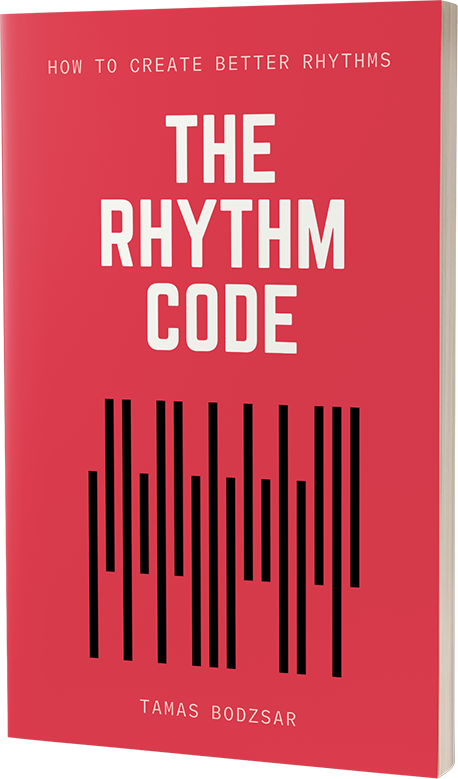
It’s obvious that all songwriters want to create a chord progression that is interesting and effective so listeners will be engaged while they listen to the song.
But what if your chord progression is too simple or sounds boring? How can we create a more effective chord progression without overcomplicating the song?
We can use countless songwriting tools to make a chord progression sound more interesting, but I’m going to write down only a few of them here. If you want to learn more, you can go through my course to learn the tools that are used by successful songwriters.
1. Borrowed chords
One of the tools is when we use borrowed chords. What are borrowed chords?
We probably all start to write songs using only diatonic chords. For example, these are the diatonic chords in the key of C major: C, Dm , Em , F , G , Am , Bdim
So everything inside the key. When we use a chord from another key, we call it “borrowed” chord, because we borrow it from another key. You shouldn’t confuse this with modulation! The song will be still in the key of C major.
For example, let’s take a look at the song “F*ck You” by Cee Lo Green. This song is in the key of C major, and here is the chord progression:
C – D – F – C
Listen to the song here:
As you can see, the second chord is a D major (D – F# – A), which is not part of the C major key. This second chord is a borrowed chord.
Try to play the chords (on your piano or guitar) with a Dm. Listen to the difference. They both sound good, but the borrowed chord makes the chord progression a little bit more interesting and unique.
(By the way: Contrary to a misbelief, this chord does NOT make the song into a Lydian mode. I explain this in more detail here.)
I go into more details about borrowed chords, how to use them and what are the most common borrowed chords in the online course.
2. Secondary dominant chords
If we stay in the key of C major, we know that the main dominant chord is the V (G) chord. But we can create a secondary dominant if we change one of the chords into a dominant seventh chord. For example, we can change the tonic I. chord into a C7 chord (C – E – G – Bb), and this chord becomes the secondary dominant.
(Obviously, this is also a borrowed chord, but not all borrowed chords are secondary dominants.)
A secondary dominant only makes sense if the NEXT chord is a fourth interval higher (an F major chord in this case). For example, here is a chord progression (in the key of C major):
C – C7 – F
I – I7 – IV
So the last two chords make the illusion of a V – I cadence, even though we are still in the key of C major.
A concrete example would be the song “Thank U Next” by Ariana Grande. Here is the chord progression of this song:
Gbmaj7 – F7 – Bbm7 – Db7
IVmaj7 – III7 – VIm7 – I7
Listen to the song here:
Even though there is no Db major chord in the song, it is still in the key of Db major! So the tonic I. chord became a secondary dominant, and the next chord is a fourth interval higher, the IV chord (Gbmaj7).
3. The II – V trick
And if we are using dominant chords, we can create the “illusion” of a IIm7 – V7 cadence. This cadence is mostly used in jazz, but we can absolutely use it in popular genres too, especially because many pop songs have a jazzy chord progression. Like this previous example “Thank U Next”.
So how can you create this trick? Let’s take a look at the chord progression of this previous song. This was the original chord progression:
Gbmaj7 | F7 | Bbm7 | Db7
IVmaj7 | III7 | VIm7 | I7
The secondary dominant chord is the I7 (Db7) chord. So if Db7 is the perceived “V7”, then the “IIm7” is Abm7.
(It’s not really a IIm7 – V7, because the tonal center is still Db. So in reality it’s Vm7 – I7, but it SOUNDS LIKE a IIm7 – V7 cadence.)
In other words: the chord Db7 became a Abm7 – Db7 cadence, and it SOUNDS LIKE a typical IIm7 – V7 cadence.
So here is the final result:
Gbmaj7 | F7 | Bbm7 | Abm7 Db7
IVmaj7 | III7 | VIm7 | Vm7 I7
It’s important to notice that the Db7 chord takes up one bar (four beats), so if this chord becomes a Abm7 – Db7 cadence, those two chords will need to fit into that one bar.
4. Substitute chords
Borrowed chords and secondary dominants are substitutes too, but there are many more possibilities for substituting chords. Basically, we can use ALL 12 notes for root note, even if we stay in the same key.
I wrote a whole chapter about chord substitutions in the Songwriting Essentials course, and it would be too long to explain it here, but here are some examples.
My favorite examples for substitutions are the songs from Jamiroquai because they use very “adventurous” chord substitutions, and their songs still sound great.
Here is the chord progression of the chorus in Too Young To Die:
Cm7 – Dbm7 – Abm7 – Bbm7
This chord progression sounds extreme, but if we eliminate chord substitutions, the chord progression would be this:
Cm – G – Fm – G
Im – V – IVm – V
Of course, this sounds very different, but if we substitute the chords, we can change this chord progression into the one above. In the songwriting course, I give you the formula for how you can use chord substitutions like this.
Another example is “Two Completely Different Things”. Here is the original chord progression of the chorus:
F | F7 | Bbm7 Eb7 | Dbmaj7 Gbmaj7
This chord progression looks complicated too, but again, if we eliminate chord substitutions, the chord progression would be:
F | F | Bb C | Bb C
I | I | IV V | IV V
Let’s take a look at a more popular song, “Happy” by Pharrell Williams. I analyze this song through many chapters in the course because the song might sound simple, but there are MANY great songwriting tools in it.
Here is the chord progression of the chorus:
Dbmaj7 | Cm7 | Cm7 | F7
And here is the same chord progression if we eliminate chord substitutions:
Bb | C | C | F
IV | V | V | I
In the songwriting course, I give you the formula for how you can use chord substitutions like these to make your songs more interesting.
5. Seventh chords
Instead of using only triads, you can use seventh chords in your song. Seventh chords typically make chord progressions sound more “smooth” (especially m7 and major7 chords!) and a little bit more jazzy.
The above songs are all great examples for those smooth, jazzy chord progressions:
Happy by Pharrell Williams
Thank U Next by Ariana Grande
Literally any song from Jamiroquai
How can you use seventh chords? Take your chord progression of triads, and try the seventh note on any of the chords. Always follow your ear. Does it sound good? This is the only important thing.
Keep in mind that there is a different rule for creating melodies on seventh chords than creating melodies on triads. (There are more details about this in the course.)
6. Extended chords
You can make even jazzier chord progressions if you use extended chords. What are extended chords?
Everything “beyond” seventh chords: 9, 11, 13 chords.

I wrote a complete article about this topic here: when you can use extended chords in songwriting.
7. Rhythm
Sometimes there is nothing wrong with the chord progression, and you can make it sound more interesting without changing any chord, but using a better rhythm.
Rhythm is a HUUUGELY overlooked topic in songwriting. Mostly because we didn’t have a theory for rhythm… until now! Fortunately, Songwriting Essentials students already have a “hack” to create better rhythms. This hack is the Rhythm Code.
Let’s take a look at an extremely simple example. The song is “Hello” by Adele. Here is the chord progression of the verse:
Fm – Ab – Eb – Db
VIm – I – V – IV
In theory, this is a four-bar chord progression, and each bar contains one chord.

But this is NOT what’s happening in the song. They play the Ab and the Db chords one beat EARLIER. This is called anticipation:

This is an extremely simple example of how a small change in rhythm can make your chord progression sound more interesting.
This song is utilizing the system of the Rhythm Code. The Rhythm Code is a “hack” I discovered, which helps us create better rhythms. You can learn the complete formula from our online course.
In Summary
You can create more interesting chord progressions by:
1. Using borrowed chords from other keys.
2. Using secondary dominants.
3. Creating the illusion of a IIm7 – V7 from any V7 chord.
4. Using chord substitutions.
5. Using seventh chords.
6. Using extended chords.
7. Or if nothing is wrong with your chord progressions, creating a better rhythm.
The secret pattern behind successful songs
Get the eBook for $4.99

